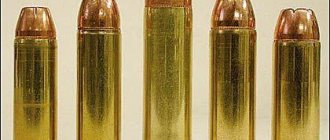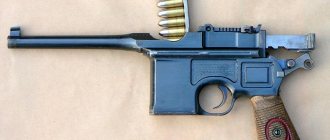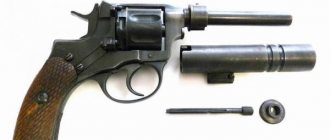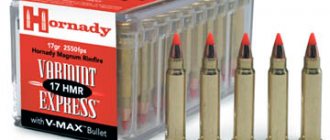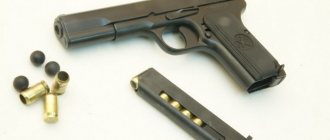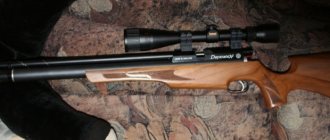The company began producing the Smith Wesson Magnum 500 revolver in 2002, and this model has become one of the most powerful pistols to date. The revolver uses a .500 caliber cartridge and features a large powder load and a heavy 12.7 mm bullet, capable of punching right through a car engine and continuing its flight.
Such revolvers are produced for several purposes. They are primarily used when hunting big game. In particular, during bear hunting. The pistol is also often used as a self-defense weapon. But for these purposes the model is too heavy and clumsy.
Design
The modern 357 Magnum revolver is produced by S&W under the name Model 27. The weapon is mostly made of weapons-grade steel.
Although there are options made of stainless steel or using polymers or aluminum. However, these are small series, and they are lost against the background of the main model. They also all differ in handle materials. The original model is designed for shooting up to 25 – 50 meters. Further, the power of the shot begins to decrease sharply due to the large mass of the bullet. For ease of aiming, there are fixed rear sights and front sights, but options for installing a laser target or collimator are possible. Literally every detail is subject to tuning. Fortunately, the revolver is simple in its design.
The pistol barrel is equipped with rifling to improve ballistics and is tightly attached to the weapon frame. Ammunition is supplied by a drum with 6 charges. The trigger is double action and the weapon is cocked thanks to self-cocking from the trigger or manual release of the hammer. There are options without self-cocking for lovers of the classics.
Revolver design
Magnum 500 revolvers are always made entirely of weapons-grade steel. This is necessary to prevent deformation of the structure from firing. Softer materials may begin to deform and will eventually cause the weapon to fail. The pistol grip has different finishes depending on the model. Aesthetes can generally order a product with a wooden handle.
Ammunition is supplied by a 5-charge drum located in the center of the product. Rotation occurs due to the force on the trigger. The trigger is always double acting. That is, two shooting options are possible: cocking the trigger by hand and self-cocking from the hook.
Standard sights are located on top of the barrel and receiver. They are mechanical and designed to fire up to 100 meters. At the same time, no one cancels the possibility of tuning, and tactical grips, flashlights and laser aimers can be attached to the barrel. There is an option to install low-power optics for more accurate fire.
Notes
- ↑ 1 2
Model S&W500
(unspecified)
. Smith & Wesson Company. Retrieved December 22, 2022. - ↑ 1 2
Smith & Wesson Model 500 .50-Cal.
Magnum Is The King Of Handguns (English), Popular Mechanics
(16 September 2003). Retrieved January 24, 2022. - ↑ 12
Lock n' Load with R. Lee Ermey - 04 Pistols - ↑ 1 2 Sweeney, Patrick.
The Biggest Magnum // The Gun Digest Book of Smith & Wesson (unspecified). - Iola, Wisconsin: Gun Digest Books, 2004. - pp. 154-162. — ISBN 1-4402-2487-0. - ↑ 1 2 Supica, Jim;
Nahas, Richard. Standard Catalog of Smith & Wesson (unspecified). - 4. - Iola, Wisconsin: F+W Media, Inc. (English) Russian, 2022. - pp. 292-293. — ISBN 978-1-4402-4563-3. - Africa Hunts with Smith & Wesson 500. Hampton, Mark
. To Africa with a .500 S&W, American Handgunner. Archived from the original on August 15, 2022. Retrieved September 27, 2016. - Thompson, Leroy
The John Ross S&W Performance Center 5″ .500 Magnum
(unspecified)
.
GunBlast.com
. Retrieved October 22, 2010.
Cartridge 9×18 mm PM. Why is he called “the patron who lives on his last breath”? types of cartridges, weapons, perspectives
History of creation
The Smith Wesson company has been on the arms market since the mid-nineteenth century and has proven itself well. First of all, they are known as the creators of ammunition and self-loading weapons. In particular, revolvers and rifles. It is interesting that the company’s revolvers were in service with the Russian Empire, and later with the Soviet Union.
It was in this company that they first created a high-power pistol cartridge and began selling it under the Magnum brand. And for each new ammunition they created their own revolver. Later, the name “magnum” was picked up by other companies, and cartridges with this index were no longer only pistol cartridges. In Canada, for hunting rifles, there is a 12-gauge cartridge with an increased amount of gunpowder, which is called a “magnum”.
The 500 SW Magnum itself was created in 2002 as a response to the Desert Eagle self-loading pistol, which began to rapidly replace the company’s earlier revolvers. Interestingly, before the movie “Dirty Harry” with Clint Eastwood, Magnum revolvers were not widely used. However, the tape gave rise to a real boom in large-caliber pistols.
The official name of the revolver is Model 500. It was created in conjunction with the .500 magnum cartridge.
Options
- Model 500ES: 2.75" barrel, stainless steel Emergency Survival snub nose revolver with bright orange Hogue grip (discontinued December 2009).
- Model 500: 3.5" barrel, stainless steel, with HI VIZ fiber optic sight.
- Model 500: 4″ barrel, stainless steel, with two compensators.
- Model 500: 6.5″ barrel, half rimmed, stainless steel with compensator (discontinued 2022).
- Model 500: 7.5″ barrel, stainless steel, with muzzle brake.
- Model 500: 8.38″ barrel, stainless steel with compensator.
- Model 500 HI VIZ: 8.38″ barrel, stainless steel, with replaceable compensators.
- Model 500: 10.5-inch German Lothar-Walther rifle barrel, brushed stainless steel, with muzzle brake.
Cartridge 7.62×25 mm TT arr. 1930 Why is it called “the cartridge that has not exhausted its capabilities”?
More options are available at the Smith & Wesson Performance Center. Like all Smith & Wesson revolvers, "custom" variants are available in special production runs with a minimum order of 500 pieces. An example is the John Ross Performance Center 5″ .500 S&W Magnum, which has a 5″ barrel with an external muzzle nut instead of a muzzle brake or compensator and a dovetail front sight.
Modifications and options
All revolver models use the 500 SW Magnum cartridge and differ mainly in case materials, barrel length and the presence of additional muzzle brakes-compensators. The compact version has a barrel length of 4 inches, and the longest one is 10. In all other respects, the products are similar to each other and to the company’s previous products.
Separately, it is worth mentioning options with additional chrome plating or made of stainless steel. It is worth understanding that pistols in this category are mainly used in difficult natural conditions and they must have a large margin of resistance to external factors.
Footnotes[]
- "500 S&W 300 gr FTX LEVERevolution." Hornady.com
. Hornady Manufacturing Company. https://www.hornady.com/store/500-SW-300-gr-FTX-LEVERevolution. Retrieved September 2, 2010. - “500 S&W Special 350gr CORBON Hunter JHP.” Dakota Ammo
. Cor-bon. https://www.dakotaammo.net/CORregBON-Hunter/500-SW-Special-350gr-CORBON-Hunter-JHP/HT500S350-12/300/Product. Retrieved September 2, 2010. - Winchester
- DoubleTap Ammo
- "WWW.BALLISTICSUPPLY.NET." Archived from the original on 2009-07-20. https://www.webcitation.org/5iQD2fZa8. Retrieved 2009-07-04.
- ↑ Metcalf, Dick. "Smith & Wesson's Monster Magnum." Shooting Times November 2003
. Archived from the original on March 1, 2009. https://web.archive.org/web/20090301013816/https://shootingtimes.com/handgun_reviews/monster_1103/. - ↑ "Smith & Wesson Model 500 .50-Cal. Magnum Is The King Of Handguns." Popular Mechanics
. 1 September 2003. https://www.popularmechanics.com/outdoors/recreation/1277336. - ↑ “Maximum Cartridge/Minimum Chamber – 500 Smith & Wesson Magnum.” SAAMI. 23 June 2004. https://www.saami.org/PubResources/CC_Drawings/Pistol/500%20SandW%20Magnum.pdf. Retrieved February 6, 2011.
- Ross, John F.. "Relative Strengths and Weaknesses." john-ross.net
. John Ross. Archived from the original on October 7, 2010. https://web.archive.org/web/20101007221220/https://john-ross.net/pdfs/mags.pdf. Retrieved September 5, 2010. - Ballistics data from COR-BON.
- .375 JDJ loading data by Accurate Powder
- Hogdon load data, search for .45-70 pistol loads.
- ↑ "NEF's biggest and baddest Handi-Rifle: yeah, it's a .50", Guns Magazine
, Jan, 2007 by John Taffin. - "Low Recoil 500 Smith & Wesson 350 gr. Super-X Jacketed Hollow Point.” Winchester Ammunition
. Winchester. Archived from the original on 12 November 2010. https://web.archive.org/web/20101112082818/https://www.winchester.com/Products/handgun-ammunition/super-x/jacketed-hollow-point/Pages /X500SW.aspx. Retrieved September 4, 2010. - “500 S&W Special 350gr CORBON Hunter JHP.” Dakota Ammo
. Cor-bon. https://www.dakotaammo.net/CORBON-Hunter/500-SW-Special-350gr-COR-BON-Hunter-JHP/HT500S350-12/300/Product. Retrieved September 2, 2010. - "X-Large Frame". smith-wesson.com
. Smith & Wesson. Archived from the original on 14 September 2010. https://web.archive.org/web/20100914014836/https://www.smith-wesson.com/webapp/wcs/stores/servlet/Category4_750001_750051_757771_-1_757767_757751_image. Retrieved September 4, 2010. - Carlson, Dan. "The Beast" cabelas.com
. Cabela's. https://www.cabelas.com/story-123/carlson_beast/10201/The%252BBeast.shtml. Retrieved September 4, 2010. - Taffin, John (2004). "King of the Magnums: S&W's .500 Master-Blaster." bnet.com
. American Handgunner Jan-Feb 2004. https://findarticles.com/p/articles/mi_m0BTT/is_167_28/ai_110457316/?tag=content;col1. Retrieved September 4, 2010. - ↑ "Product: Model S&W 500". Smith & Wesson
. https://www.smith-wesson.com/webapp/wcs/stores/servlet/Product4_750001_750051_764948_-1_757771_757767_757751. Retrieved September 4, 2010. - Hampton, Mark. "To Africa with a .500 S&W." American Handgunner, January–February 2004.
- ↑ Metcalf, Dick. "Bad, Badder, Baddest." Guns & Ammo Handgun
. Archived from the original on October 17, 2010. https://web.archive.org/web/20101017132015/https://www.handgunsmag.com/featured_handguns/HG_badbadder_200909/index.html. Retrieved September 2, 2010.
Is it legal to convert the MP-371 signal pistol to the 10 tk cartridge?
How the revolver works
Design of a Nagant system revolver (soldier's model) The main parts and mechanisms of a seven-shot Nagant system revolver are:
- trunk;
- frame with handle;
- drum;
- dual-purpose trigger mechanism;
- drum feed and fixation mechanism;
- mechanism for removing spent cartridges;
- sighting devices;
- fuse.
Preparation for a shot in this pistol occurs automatically, under the influence of exhaust gases after the shot. It was only necessary to initially cock the trigger. Further, the energy of the exhaust gases did all the work - it activated the cocking mechanism and turned the drum to the next cartridge.
"Winchester" model 1892, caliber 44-40
A pleasant and respected old man - a lever-action Winchester, model 1892. Judging by the video, Greg Kinman himself has special reverent feelings for this example of an ancient weapon. Although the shooting accuracy is still such that many modern guns can envy.
Greg Kinman is a popular gun blogger and retired school teacher from Tennessee. He has been making his videos with his son since 2007 and since then he has made many videos about his favorite hobby - guns of all kinds. During this time, he managed to shoot from a variety of incarnations of engineering, but most of all he has warm feelings for non-automatic weapons. Revolvers, antique rifles, shotguns are his all-time favorites. Moreover, he does not protect his collection by blowing away specks of dust, but actively shoots from all these old men.
He gained his popularity as “that crazy redneck grandfather who loves guns.” But Greg himself, being an intelligent person, is not offended and continues to make his detailed and extremely “cozy” reviews.
Pfeifer Zeliska revolver in caliber 600 Nitro Express
In 1995, the Austrian gunsmith and lover of shooting powerful revolvers, Adolf Celiska, decided to create a powerful revolver. After experimenting with charges, he contacted Pfeifer.
Based on his sketches, a revolver weighing 6 kg and 55 cm long was made. The revolver does not have recoil-reducing devices, so shooting without a stock is almost impossible: at best, the weapon will fly out of your hands, and at worst, it can cause injury to the wrist. So you're unlikely to be able to shoot from the hip like Clint Eastwood. Muzzle energy – 6230 J. For comparison: for the Makarov pistol it is 300 J. The cartridges used are heavy-duty 600 Nitro Express.
As indicated on the manufacturer’s website, they are intended for hunting elephants and rhinoceroses, and it is not necessary to hit the “kill” places, it is enough just not to miss the target.
Model 19 – lightness and comfort
The revolvers that were described earlier were undoubtedly very good. But any good thing can be made even better, which is what the same corporation, Smith & Wesson, did. Experiments with various types of steel and heat treatment processes lasted for a whole year, the purpose of which was to increase the strength of the revolver’s structure without losing its lightness and ease of shooting. As a result, on November 15, 1955, a new brainchild of Smith & Wesson was born - the .357 Combat Magnum, which was later renamed Model 19. This pistol received a lighter and more compact, but at the same time durable frame. Also, for even greater shooting comfort, the cheeks of the revolver handle were enlarged. This model is still produced by some US weapons factories.
Specifications
To appreciate the “scale” of the weapon, let’s compare it with other, previous Magnums.
| Model 500 | Model 629 | Model 19 | |
| Caliber | .500 Magnum | .44 Magnum | .357 Magnum |
| Drum capacity, cartridges | 5 | 6 | 6 |
| Barrel length, mm | 213 | 152 | 108 |
| Total length, mm | 381 | 294 | 251 |
| Weight, kg | 1,95 | 1,27 | 1 |
To complete the picture, we point out that the muzzle energy of the .357 Magnum is in the range of 700-800 joules, and the .44 Magnum is 1000-2000 joules. The power of .500 caliber ammunition is 3000-4000 joules.
It should be noted that if the .44 caliber Magnum was assessed as a weapon in which it was possible to combine high power, relative shooting comfort and acceptable weight, the “five hundredth” can only be credited with power. Do not forget about the high price of both weapons and ammunition.
In the niche of “personal weapons” with ultra-high power, the “500th” has such a competitor as the BFR produced by Magnum Research. Its latest modifications are also capable of using .500 and .460 ammunition. The BFR is distinguished from the Smith-Wesson by a single-action trigger and a non-reclining drum.
It is also difficult to carry even the most “compact” options concealed
The ballistics of the cartridge allows you to achieve good accuracy, but in targeted shooting it is important that the weapon minimally changes its position after firing
The huge recoil of the “500th” is guaranteed to dislodge it even with the muzzle brake installed. But this weapon still has practical applications. This is hunting. The power of the cartridge allows you to catch any North American game. In addition, in Alaska, where a person who goes “out into nature” has a non-zero chance of encountering a bear, a large-caliber revolver is an effective means of self-defense.
Performance characteristics
The Magnum 500 revolver has the following technical parameters.
| Weight, kg | 1,59 – 2,26 |
| Bullet flight speed, meters per second | 632 |
| Barrel length, mm | 191 |
| Sighting range, m | 50 |
| Caliber, mm | 12,7 |
| Cartridge | .500SW |
| Shot energy, J | About 4,000 |
| Number of charges | 5 |
Each revolver is carefully checked during production and quality is monitored. This allows us to achieve the same characteristics for each product released.
The history of the creation of the Nagan-M traumatizer
In 1878, the first Nagan revolver appeared at the enterprise of two brothers in Belgium. The system has gone through a long process of improvement and operation. The weapon took part in two world wars and is still found as service equipment.
Revolver and 10X32 cartridges
It was decided to convert part of the 1985 issue into “traumas”. Two companies got down to business:
- IzhMash;
- Hammer.
The first one began production much earlier and by the time its rival appeared on the market it was well tested. Structurally, it had several shortcomings that could be eliminated on our own without much difficulty. The product was named “Naganych”.
IzhMash began assembling traumatic revolvers in 2008. The new product had a better build quality, however, it is difficult to call the two versions identical. The fact is that they are designed to use different cartridges. The Nagan-M does not allow firing two-bullet cartridges, since the second one gets stuck between the breech of the barrel and the drum.
Smith & Wesson history of legendary weapons
However, this venture failed, and in 1856 they entered into a second partnership in Springfield and began producing small Smith Wesson convertible revolvers. These pistols had fully drilled cylinder chambers that could be accessed by “breaking” the barrel upward at a hinge on the front of the upper joint, and fired self-contained metal cartridges: the original .22 caliber ammunition—Smith and Wesson's own design.
The American Civil War made Smith and Wesson the leading manufacturer of revolvers. In the 1870s, the introduction of large-bore Smith Wesson convertible revolvers (a "break" of the revolver at the hinge in front of the trigger guard exposed the rear of the cylinder), firing more powerful cartridges, opened up business in the American West and around the world.
Smith & Wesson logo
Smith & Wesson's visual identity is a symbol of the company's heritage and the value of tradition. The brand has an elegant and calm logo, which speaks of its reliability and stability.
The Smith & Wesson logo consists of a wordmark with an emblem above it. The nameplate is written in a sleek, classic serif font, with soft letter lines and distinct serifs. The ampersand (&) is lightly italicized, adding a subtle touch to the logo.
The Smith & Wesson logo features a stylized brand monogram enclosed in a circular frame. It has the same blue color as the lettering, which creates a feeling of harmony and balance.
Smith & Wesson in the 19th century
Founded in 1852 by Horace Smith and Daniel B. Wesson, the company developed some of the most widely used cartridges in the firearms world and also produces many iconic revolvers, pistols and rifles. In 2022, the company's gun sales exceeded $773 million.
Like Colt or other pioneers in the development of modern firearms in the mid-19th century, Smith Wesson began by considering not only the weapon, but also the ammunition it would use. In 1852, the duo formed a partnership to produce firearms that could fire a completely self-contained cartridge.
Nearly half a century later, the company released the Model 10 .38 Military & Police, an innovative firearm with a rugged frame and manual case extraction system. Along with guns like the Colt M1911, which was known for its durability, the Model 10 remained in continuous production since 1899, with over six million units produced.
Horace Smith and Daniel Wesson created a company that has been an industry leader in handgun and cartridge innovation since 1852. Before forming the partnership, Smith learned about firearms while working at the National Armory in Springfield, Massachusetts, and Wesson was an apprentice to his brother Edwin, who was a leading gun manufacturer at the time.
Smith & Wesson 20th century
In the second millennium, the company supplied a large number of breakpoint revolvers to the needs of the army and police around the world. During World War I and World War II, revolvers were provided to the US Army and allied forces.
The company also noted the release of its own calibers: .357 and .44 magnum; and a line of revolver models for these calibers (the series is called Magnum).
In the mid-1950s, Smith & Wesson introduced its first semi-automatic pistol (the Model 39), marking the beginning of several generations of self-loading secondary weapons.

